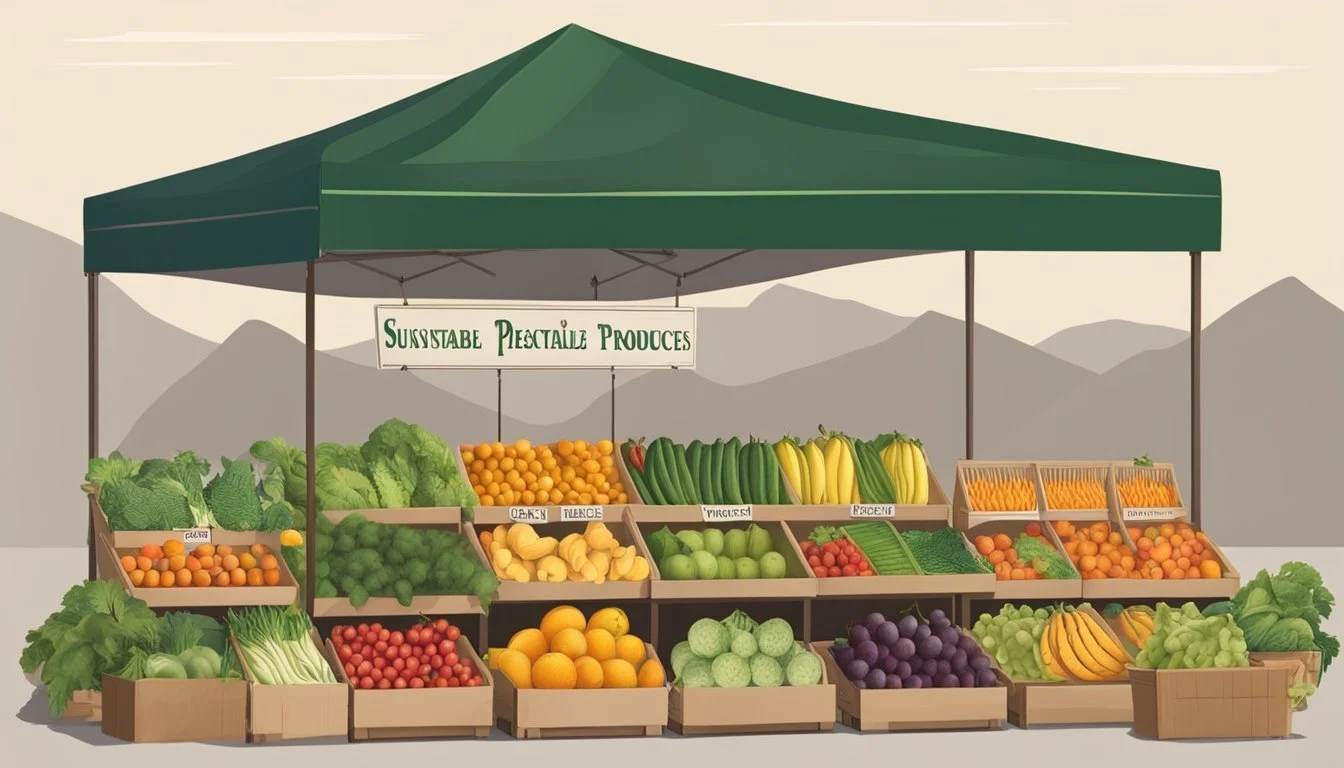Utah Seasonal Fruit & Vegetables in December
A Guide to Fresh Produce
This Article is Part of our Utah Seasonal Fruit & Veg Calendar
Utah's diverse climate allows for a multitude of fruits and vegetables to flourish, even in the colder months. As December's chill sets in, farmers and markets across the state are stocked with a variety of fresh produce that is specific to the season. While some might associate the holiday month with sweet treats and festive feasts, Utah's agricultural scene provides a bounty of fresh, seasonal produce that complements any winter table.
Seasonal fruits that are available at this time of year may not be as abundant as the summer harvest, but they offer a taste that's equally as fresh and flavorful. Root vegetables and hardy winter greens are common finds at local farmers markets, delivering both nutrition and taste to consumers looking for seasonal options. These markets play a crucial role in providing access to fresh, locally-sourced produce, supporting both Utah's economy and the healthful eating habits of its residents.
Consumers visiting Utah's markets can expect to find a selection of seasonal produce that includes items such as winter squash, apples, and a variety of leafy greens. These items are often at their peak in flavor and nutritional content, making December an ideal time to explore the richness of Utah's produce offerings. Despite the cold weather, the state's agricultural producers work diligently to ensure a steady supply of fresh fruits and vegetables to the community throughout the winter season.
Understanding Seasonality in Utah
Utah's diverse climate zones and winter weather patterns critically influence the availability and seasonality of local produce in December.
Agricultural Climate Zones
Utah is home to several agricultural climate zones, ranging from the cold, high-altitude areas of the Uinta Mountains to the warmer, lower elevations of the southern valleys. Each zone fosters different growing conditions, affecting the growing season lengths and the types of fruits and vegetables that can thrive. For instance, areas with a longer fall might support the growth of winter squash well into late summer, whereas more abrupt temperature transitions might conclude their growing season sooner.
Northern Utah Zones: Characterized by cooler temperatures and shorter growing seasons. Ideal for cold-hardy crops.
Central Utah Zones: Transitional zones with moderate winters, allowing for an extended variety of crops.
Southern Utah Zones: Tend to have milder winters and longer growing seasons, suitable for a broader range of produce, extending into late summer and fall.
The Impact of Winter Weather
Winter weather greatly impacts Utah's agricultural output, especially in December. Temperatures often drop below freezing, which can halt the growth of many crops. However, some hardy vegetables like horseradish and leeks can withstand the cold, and as such, they are still available during this season. Farmers often use protective measures such as greenhouses or row covers to extend the life of their crops, but in general, fresh local produce becomes more limited during winter months.
Typical Winter Temperatures: Can range from mild in the southern region to sub-freezing in the north, affecting the types of produce that can survive.
Winter Produce: Despite the cold, some root vegetables and winter squashes, which are harvested in the fall, remain available due to their storage capabilities.
December Seasonal Vegetables
December in Utah brings a variety of hearty vegetables that thrive in the cooler temperatures. These vegetables are often characterized by their robust flavors and textures, making them ideal for warm and comforting winter dishes.
Root Vegetables and Tubers
Root vegetables and tubers are winter staples. Potatoes and carrots (how long do carrots last?) are versatile, offering both nutritional value and flavor to a multitude of dishes. Beets (how long do beets last?) add a sweet, earthy tone to salads and sides and are complemented by the more subdued flavors of parsnips and turnips. Rutabaga can be mashed or roasted, creating a dish that has a deeper and somewhat sweeter profile compared to its root vegetable counterparts.
Potatoes: Excellent for roasting
Carrots: Ideal in soups or glazed
Beets: Can be roasted for salads
Parsnips: Mash well with potatoes
Turnips: Roast for a caramelized treat
Rutabaga: Sweet, hearty when cooked
Leafy Greens and Brassicas
The brisk weather supports a range of leafy greens and brassicas that contribute vivid colors and textured layers to December meals. Kale and cabbage offer dark, leafy greens packed with nutrients. They can be sautéed or added to soups. Brussels sprouts (how long do brussels sprouts last?), with their nutty flavor, are a classic winter vegetable that can be enjoyed roasted or steamed. Broccoli and cauliflower also share the stage, serving as nutritious options that are excellent steamed, roasted, or used in stir-fries.
Kale: Sautéed or in soups
Cabbage: Shredded in salads or cooked
Brussels Sprouts: Best roasted
Broccoli: Versatile, good for a variety of dishes
Cauliflower: Mild and adaptable
Squash Varieties
The season's squash comes in many shapes and sizes, with varieties suitable for both savory and sweet preparations. While not exclusively a December crop, winter squash such as butternut can still be found. They are dense and sweet, suitable for roasting and integrating into warm seasonal meals.
Butternut Squash: (how long does butternut squash last?) Roast to enhance its natural sugars
Acorn Squash: Can be baked and stuffed with a filling
Throughout December, these vegetables offer chefs and home cooks alike a cornucopia of options for creating nourishing and satisfying meals.
December Seasonal Fruits
In December, Utah's markets are abundant with a variety of fresh and nutritious fruits, particularly citrus and pome fruits, which are in their prime during the cold season.
Citrus Fruits
Citrus fruits thrive in winter, providing a burst of sunshine and vitamin C during Utah's chillier months. They are typically at their juiciest and sweetest as the cold sets in.
Oranges: A winter staple, they are perfect for eating raw or using in holiday recipes.
Clementines: These small, sweet citrus fruits are seedless, making them a convenient and popular snack.
Oranges and clementines are not only delicious when consumed fresh but also can be used to add a tangy flavor to dishes or as a garnish for festive drinks.
Pome Fruits
Pome fruits, most notably apples and pears, are another highlight of the December produce selection in Utah. While they are harvested in the fall, many varieties are still available in December due to cold storage techniques that keep them fresh.
Apples: With a range of varieties, apples are versatile for both raw eating and cooking.
Pears: Known for their buttery texture, pears are delicious when raw and offer a subtle, sweet flavor.
These fruits serve as key ingredients for numerous holiday recipes, from hearty pies to warm, spiced cider.
Preparing Seasonal Produce
In Utah's December, chefs and home cooks alike turn to robust cooking techniques and holiday meal ideas to make the most of the seasonal fruits and vegetables available. Utilizing these methods not only enhances flavor but also celebrates the produce's peak freshness.
Cooking Techniques
Roasting: This method intensifies the natural sugars in root vegetables such as carrots and parsnips, creating a caramelized exterior and tender interior. A simple drizzle of olive oil, salt, and pepper is often enough to elevate their flavors.
Vegetable Temp (F) Time Carrots 425 20-25 min Parsnips 425 20-25 min
Stewing and Soups: Building layers of flavor with seasonal vegetables like squash and kale can create hearty winter stews and soups. They can simmer slowly, allowing all the ingredients to meld together harmoniously.
Example: Butternut squash stew with white beans and kale.
Raw Preparations: Slicing root vegetables thinly transforms them into crisp additions for slaws or salads, often dressed with a bright vinaigrette to balance their earthy notes.
Example: Beet and carrot slaw with a citrus dressing.
Holiday Meal Ideas
Mashes: Root vegetables become the star of holiday tables when they're boiled and mashed. Seasonal additions like roasted garlic or fresh herbs can elevate a simple potato or sweet potato mash.
Example: Garlic mashed potatoes with a touch of rosemary.
Seasonal Fruit Applications: Fruits such as apples and pears can be baked into desserts or added to savory dishes to provide a sweet contrast to rich holiday meals (What wine goes well with holiday meals?).
Example: Roasted pear salad with arugula and blue cheese.
Holiday Roasts: Integrating seasonal vegetables with traditional roast meats creates a festive feast that showcases the best of December’s produce.
Example: Herb-roasted turkey with a root vegetable medley.
Local Markets and Farms
In Utah, December brings a unique assortment of local produce to markets and farms. Despite the cold weather, shoppers can find a variety of fruits and vegetables at local venues.
Farmers Markets and Their Offerings
Farmers markets in Utah continue to operate in December, albeit with fewer vendors. These markets offer a select variety of winter produce, which commonly includes items from cold storage and late harvests. Shoppers can expect to find hearty root vegetables and a range of preserved or greenhouse-grown goods. Despite the chilly season, these community hubs remain a vital source for local produce.
Root Vegetables: Carrots, beets, and potatoes available from cold storage
Preserved Goods: Jams, honey, and pickled vegetables (What wine goes well with pickled vegetables?)
Greenhouse Produce: Limited selection of greens such as kale and spinach
While the variety of fresh fruit is generally limited in December, vendors may also bring in stored apples or winter squash. Each farmers market provides a different mix, sometimes including items like onions and garlic as well. Patrons not only support the local economy but also enjoy produce that often exceeds standard grocery store freshness. Regular visitors value the direct connection with growers and the transparent origins of their food.
Sustainable Practices and Support
Utah's agricultural scene actively embraces sustainable practices which bolster the local economy and enrich community wellbeing. Through initiatives like Community Supported Agriculture and a commitment to organic farming, Utahns demonstrate strong support for local and sustainable food systems.
Community Supported Agriculture (CSA)
Community Supported Agriculture programs in Utah allow residents to subscribe to the bountiful harvests of local farms. These subscriptions directly support farmers by providing them with a reliable source of income and reduce food miles, thereby lessening the environmental impact. CSA members typically receive a share of fresh, seasonal produce each week, fostering a connection between growers and consumers and encouraging a more intimate understanding of where their food originates.
Benefits of CSA in Utah:
Freshness: produce is locally harvested and often picked within 24 hours of delivery.
Variety: members enjoy a wide range of fruits and vegetables over the season.
Community Impact: CSA models keep money within the local economy and support Utah's farmers.
Organic Farming in Utah
Organic farming practices are gaining ground in Utah as farmers and consumers alike seek more environmentally friendly alternatives to conventional agriculture. Organic farms in Utah must adhere to strict guidelines that promote soil health, conserve water and biodiversity, and eliminate the use of synthetic pesticides and fertilizers. These practices not only yield crops that are free of harmful chemicals but also contribute to the sustainability of the state's agriculture industry.
Core Principles of Organic Farming:
Soil Stewardship: maintaining soil health through natural composting, crop rotations, and cover cropping.
Water Conservation: employing irrigation techniques like drip irrigation to minimize water use.
Biodiversity: fostering diverse ecosystems by planting a variety of crops and using integrated pest management.







